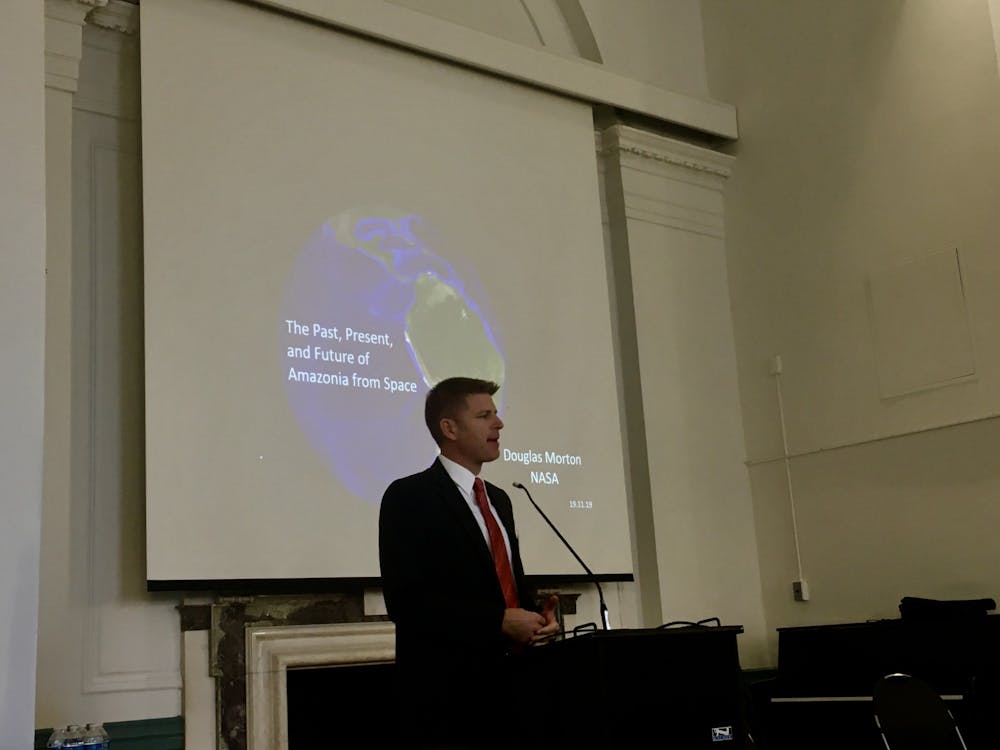The International Studies Program and the Portuguese Language Program hosted Douglas Morton, the Chief of the Biospheric Sciences Laboratory at the National Aeronautics and Space Administration’s (NASA) Goddard Space Flight Center at the Third Annual Symposium on Brazil this Tuesday.
This symposium’s theme was “Amazonian Studies: Multidisciplinary Approaches.” Martin presented his lecture, titled “The Amazon from Space: Understanding the Past, Present, and Future of Amazonia from Space,“ explaining how NASA’s technology can help to protect and understand the Amazon.
Morton has worked in Brazil for the past 18 years, focusing on the agricultural frontiers of the Amazon and engaging in international efforts to reduce emissions from deforestation and forest degradation.
Morton gave an overview of NASA’s technology and explained how he and his team have been using NASA’s satellites to track the changes in the Amazon’s physical characteristics.
“What we are doing is more than just using satellites in space,“ Morton said. “Our fundamental understanding starts with the roots in the ground, whether we are making measurements in forests or assessing species composition or... characteristics of forests in the Amazon frontier. We are talking with people and learning from farmers to have answers to the context on the ‘why.’“
Morton proceeded to explain the past, present and future of the Amazon. He marked the present state of the Amazon as beginning in 1984 and lasting until the present day, because that was the year the Landsat series was launched. The Landsat program is the longest running to acquire satellite images of Earth and contains the earliest satellite images of the Amazon.
He said that while there are more than 10,000 species of trees in the Amazon, only 227 of them compose more than half of all trees measured in Amazon. He stated that scientists can track the domestication of the trees using the smaller group.
“However, we’ve lost many of the avenues of understanding the modifications of the Amazon through deforestation,“ Morton said. “We are missing that piece of the puzzle in terms of trying to understand the story.”
Morton argued that scientists will gain a better understanding of the future of the rainforest by looking at evidence from the past and present, emphasizing the advance of agricultural production in the Amazon.
“Using satellite data, we are able to not only identify the areas of deforestation but we are also able to track what land use replaces forests,“ Morton said. “Not only the day after but even the growing season after the forest is cleared, we are able to tell the difference between areas that are in grassland versus areas that have been put into agriculture.”
Morton argued that the next challenge is for citizens to interpret the large amounts of information received daily to influence their actions. He reminded the audience that all data and information is available online because they aim to democratize science and increase transparency between science corporations and the public. He explained that in this way, members of the public can access satellite images to see how all the forest fires are connected. He expressed hope that people will make better decisions going forward based on a greater awareness of their environment.
Junior Harry Lee came to the event as part of an assignment for his class on Brazilian Culture and Civilization. However, he explained that he was also genuinely interested in the subject matter and was eager to learn about Morton’s expertise working at NASA.
“I didn’t really know much about Brazil to be honest, and... a lot of the details were more in-depth compared to what we learned in class,“ Lee said. “I would not have made the connection between space and the Amazon,“ Lee said.
Senior Anthony Wang, another student in the Brazilian Culture and Civilization class, explained their class’s participation in the symposium.
“Every person in Brazilian Culture and Civilization has to present a research topic of their choice as a group. I am predicting based on current trends whether deforestation due to cattle in the Amazon will increase,” Wang said.
Bobbi Jo Bergum, a visiting student from Towson University, came to the symposium at the suggestion of her Portuguese professor. She stated that Morton offered an important perspective about Brazilian President Jair Bolsonaro’s conduct with regards to the Amazon.
“He made a really interesting point about how Bolsonaro is treating it like it’s a Brazilian problem, but it’s affecting everywhere in the world. And that’s what he was showing with the satellite images, how it’s all connected,” Bergum said.
She said that the symposiums were important for students.
“Especially if it’s not our area of study, it’s a chance for us to know what is happening and hear from scholars what’s happening in the world so we can advocate for change,“ she said.





